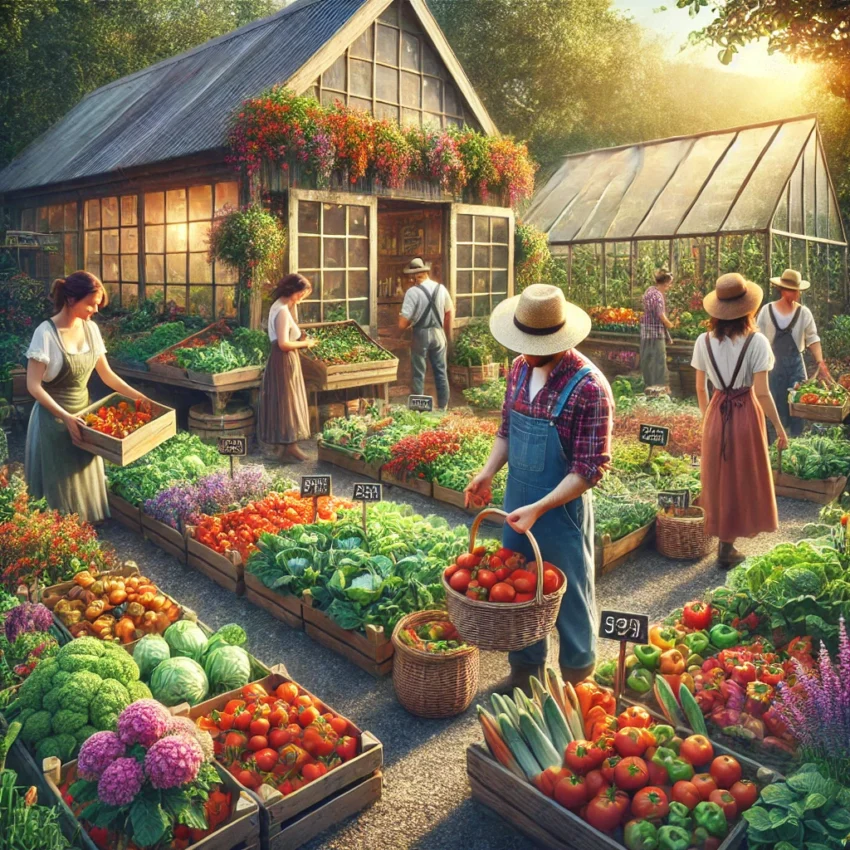Market gardening is a highly productive form of small-scale farming where growers cultivate fruits, vegetables, and flowers for direct sale to consumers, restaurants, or local markets. Unlike large-scale industrial farms that focus on monocropping, market gardens prioritize crop diversity, sustainability, and intensive growing techniques to maximize yields on limited land.
How Market Gardening Works
Market gardening relies on efficient space usage, sustainable practices, and direct-to-consumer sales. Farmers typically use small plots—often under five acres—where they grow a variety of crops throughout the year. These crops are sold through farmers’ markets, community-supported agriculture (CSA) programs, local restaurants, and farm stands.
Key Characteristics of Market Gardening
- Small-Scale Production – Usually under five acres, market gardens focus on high-value crops.
- Intensive Growing Methods – Farmers use crop rotation, companion planting, and organic fertilizers to enhance soil health and yields.
- Direct Sales to Consumers – Produce is sold at farmers’ markets, through CSA subscriptions, or to local grocers and chefs.
- Sustainable Practices – Many market gardeners emphasize organic farming, reduced pesticide use, and minimal environmental impact.
Advantages of Market Gardening
Market gardening offers numerous benefits for farmers, consumers, and the environment. Let’s explore why this agricultural method is gaining popularity.
1. Higher Profit Margins
Because market gardeners sell directly to consumers, they cut out middlemen, allowing them to earn more per unit of produce compared to conventional farming.
2. Greater Crop Diversity
Unlike large farms that grow just a few crops, market gardens cultivate a wide range of vegetables, herbs, and flowers, reducing the risk of crop failure and increasing food security.
3. Environmentally Friendly Farming
Market gardening promotes regenerative agricultural practices such as composting, no-till farming, and natural pest control, leading to improved soil health and reduced carbon emissions.
4. Fresher and Healthier Produce
Since market garden produce is grown locally and harvested at peak ripeness, consumers receive fresher, more nutritious food compared to supermarket alternatives.
Challenges of Market Gardening
Despite its benefits, market gardening comes with its own set of challenges.
1. Labor-Intensive
Unlike industrial farms that rely on machinery, market gardens require significant manual labor, from planting to harvesting.
2. Limited Land Availability
Finding affordable land in urban or suburban areas can be difficult, making it challenging for new farmers to get started.
3. Seasonal Constraints
Market gardens depend on climate conditions, meaning income can fluctuate with the seasons unless growers implement season-extension techniques like greenhouses and hoop houses.
How to Start a Market Garden
If you’re interested in market gardening, here’s a step-by-step guide to help you get started.
1. Choose Your Location
Find a plot of land with good soil quality, access to water, and proximity to your target market.
2. Plan Your Crops
Select high-value, fast-growing crops that thrive in your climate and have strong market demand.
3. Invest in Essential Tools
Basic tools include hand tools, seed trays, irrigation systems, compost bins, and protective structures like row covers.
4. Develop a Sales Strategy
Decide where and how you’ll sell your produce—whether through a CSA, farmers’ market, or direct restaurant sales.
5. Implement Sustainable Practices
Use organic compost, practice crop rotation, and minimize synthetic inputs to maintain soil health and long-term farm productivity.
Conclusion
Market gardening is an effective way to grow fresh, high-quality produce while maintaining sustainable and profitable farming practices. Although it requires dedication and hands-on labor, the rewards include higher earnings, greater food security, and environmental benefits. Whether you’re an aspiring farmer or a consumer looking for fresh local produce, market gardening offers a compelling alternative to industrial agriculture.
